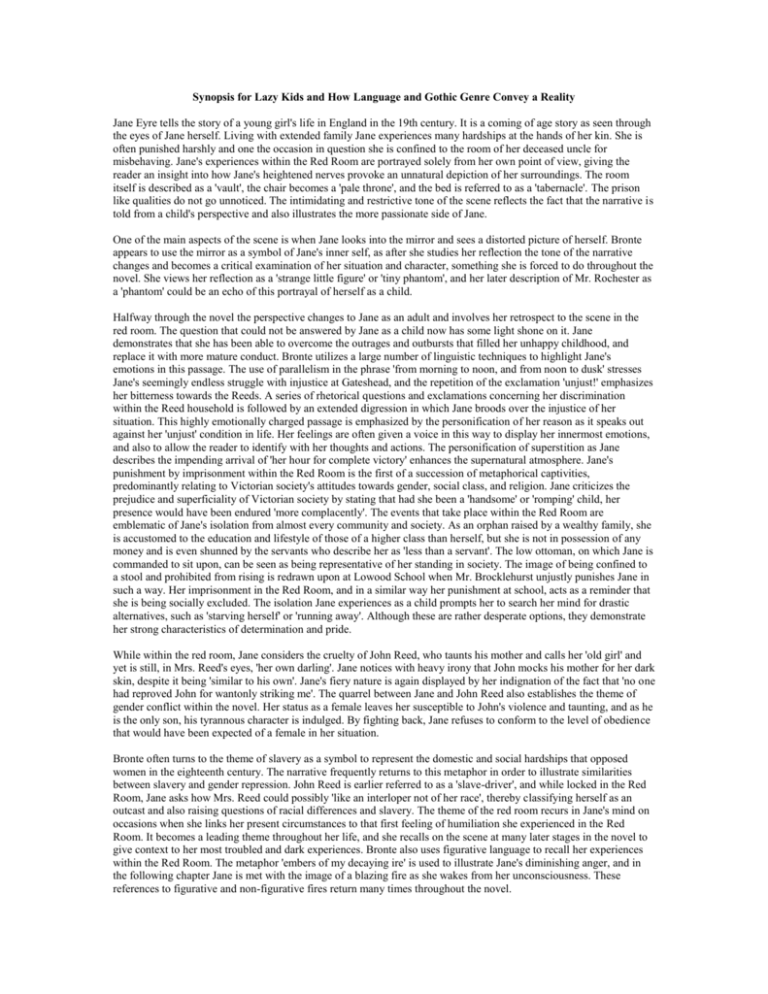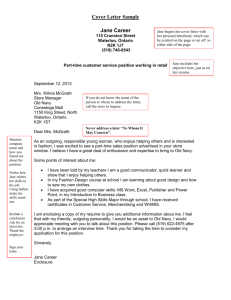Synopsis for Lazy Kids and How Language and Gothic Genre
advertisement

Synopsis for Lazy Kids and How Language and Gothic Genre Convey a Reality Jane Eyre tells the story of a young girl's life in England in the 19th century. It is a coming of age story as seen through the eyes of Jane herself. Living with extended family Jane experiences many hardships at the hands of her kin. She is often punished harshly and one the occasion in question she is confined to the room of her deceased uncle for misbehaving. Jane's experiences within the Red Room are portrayed solely from her own point of view, giving the reader an insight into how Jane's heightened nerves provoke an unnatural depiction of her surroundings. The room itself is described as a 'vault', the chair becomes a 'pale throne', and the bed is referred to as a 'tabernacle'. The prison like qualities do not go unnoticed. The intimidating and restrictive tone of the scene reflects the fact that the narrative is told from a child's perspective and also illustrates the more passionate side of Jane. One of the main aspects of the scene is when Jane looks into the mirror and sees a distorted picture of herself. Bronte appears to use the mirror as a symbol of Jane's inner self, as after she studies her reflection the tone of the narrative changes and becomes a critical examination of her situation and character, something she is forced to do throughout the novel. She views her reflection as a 'strange little figure' or 'tiny phantom', and her later description of Mr. Rochester as a 'phantom' could be an echo of this portrayal of herself as a child. Halfway through the novel the perspective changes to Jane as an adult and involves her retrospect to the scene in the red room. The question that could not be answered by Jane as a child now has some light shone on it. Jane demonstrates that she has been able to overcome the outrages and outbursts that filled her unhappy childhood, and replace it with more mature conduct. Bronte utilizes a large number of linguistic techniques to highlight Jane's emotions in this passage. The use of parallelism in the phrase 'from morning to noon, and from noon to dusk' stresses Jane's seemingly endless struggle with injustice at Gateshead, and the repetition of the exclamation 'unjust!' emphasizes her bitterness towards the Reeds. A series of rhetorical questions and exclamations concerning her discrimination within the Reed household is followed by an extended digression in which Jane broods over the injustice of her situation. This highly emotionally charged passage is emphasized by the personification of her reason as it speaks out against her 'unjust' condition in life. Her feelings are often given a voice in this way to display her innermost emotions, and also to allow the reader to identify with her thoughts and actions. The personification of superstition as Jane describes the impending arrival of 'her hour for complete victory' enhances the supernatural atmosphere. Jane's punishment by imprisonment within the Red Room is the first of a succession of metaphorical captivities, predominantly relating to Victorian society's attitudes towards gender, social class, and religion. Jane criticizes the prejudice and superficiality of Victorian society by stating that had she been a 'handsome' or 'romping' child, her presence would have been endured 'more complacently'. The events that take place within the Red Room are emblematic of Jane's isolation from almost every community and society. As an orphan raised by a wealthy family, she is accustomed to the education and lifestyle of those of a higher class than herself, but she is not in possession of any money and is even shunned by the servants who describe her as 'less than a servant'. The low ottoman, on which Jane is commanded to sit upon, can be seen as being representative of her standing in society. The image of being confined to a stool and prohibited from rising is redrawn upon at Lowood School when Mr. Brocklehurst unjustly punishes Jane in such a way. Her imprisonment in the Red Room, and in a similar way her punishment at school, acts as a reminder that she is being socially excluded. The isolation Jane experiences as a child prompts her to search her mind for drastic alternatives, such as 'starving herself' or 'running away'. Although these are rather desperate options, they demonstrate her strong characteristics of determination and pride. While within the red room, Jane considers the cruelty of John Reed, who taunts his mother and calls her 'old girl' and yet is still, in Mrs. Reed's eyes, 'her own darling'. Jane notices with heavy irony that John mocks his mother for her dark skin, despite it being 'similar to his own'. Jane's fiery nature is again displayed by her indignation of the fact that 'no one had reproved John for wantonly striking me'. The quarrel between Jane and John Reed also establishes the theme of gender conflict within the novel. Her status as a female leaves her susceptible to John's violence and taunting, and as he is the only son, his tyrannous character is indulged. By fighting back, Jane refuses to conform to the level of obedience that would have been expected of a female in her situation. Bronte often turns to the theme of slavery as a symbol to represent the domestic and social hardships that opposed women in the eighteenth century. The narrative frequently returns to this metaphor in order to illustrate similarities between slavery and gender repression. John Reed is earlier referred to as a 'slave-driver', and while locked in the Red Room, Jane asks how Mrs. Reed could possibly 'like an interloper not of her race', thereby classifying herself as an outcast and also raising questions of racial differences and slavery. The theme of the red room recurs in Jane's mind on occasions when she links her present circumstances to that first feeling of humiliation she experienced in the Red Room. It becomes a leading theme throughout her life, and she recalls on the scene at many later stages in the novel to give context to her most troubled and dark experiences. Bronte also uses figurative language to recall her experiences within the Red Room. The metaphor 'embers of my decaying ire' is used to illustrate Jane's diminishing anger, and in the following chapter Jane is met with the image of a blazing fire as she wakes from her unconsciousness. These references to figurative and non-figurative fires return many times throughout the novel. The passage is heavy with color and sound imagery, accentuating Jane's heightened senses and emotions while in the red room. The mood is intensified by the repeated descriptions of the room's 'silent' atmosphere, 'chill' air, and the gathering of 'quiet dust'. This somewhat ominous silence is not broken until the end of the extract when a sound fills Jane's ears 'like the rushing of wings'. Jane's initial impressions of the colors within the red room, such as the 'soft fawn' and 'blush of pink', do not at first seem negative, but gradually the colors around her become increasingly more threatening. The color red is highly significant, being the predominant color within the room. Red is often used in conjunction with the themes of passion and fury, and the descriptions such as the 'curtains of deep red damask' mirror physically Jane's excessively fervent character. Charlotte Bronte was greatly influenced by the Gothic novels that were in fashion before the time of Jane Eyre. The Gothic novel was popularized in the late eighteenth and early nineteenth centuries, and was defined by its use of suspense, supernatural elements, and desolate locations to generate a gloomy or chilling mood. The protagonist of the novel would generally be female, and often face distressing or morbid circumstances. In this extract, Jane seems to fit this stereotypical Gothic heroine as her situation is certainly distressing and, although she faints, she demonstrates her resolve to resist those who persecute her, a strength that, as we have seen, was common in Gothic women. The use of suspense is another Gothic technique employed within this extract. The final paragraph of the extract begins with the short, simple sentence 'A singular notion dawned upon me', and then gradually the tension increases as Jane's imagination becomes progressively more frantic and superstitious. The use of long, complex sentences and lists interspersed with commas and semi-colons give the text a fast-paced and frenzied tone. The suspense continues to increase until finally the extract reaches its climax and Jane screams. The scene within the red room is loaded with intricate Gothic imagery and details. Perhaps one of the strongest Gothic elements of the room is the fact that it is the room of her deceased uncle. Also the deep red color of the room is implicative of death and blood, and both of these aspects feature prominently in the stereotypical Gothic novel that we have read in this class like The Castle of Otranto. The descriptions of the continuous rain and whipping winds paint a vivid Gothic picture of the stormy moors that surround Gateshead that are very similar to Otranto. The supernatural elements in the passage, such as the 'rushing of wings' that fills Jane's ears and her vision of the 'herald of some coming vision from another world', are the most noticeably Gothic. The usage of such obvious Gothic elements so early in the novel forecast impending Gothic ideas and locales later in the text. Perhaps one of the strongest Gothic elements of the room is the fact that it is the room of her deceased uncle. It is the application of these Gothic characteristics that seem to give the novel its widespread appeal. However, although Charlotte Bronte incorporates many of these Gothic influences within Jane Eyre, she has developed the traditional techniques significantly from what would have been the typical Gothic of the late eighteenth century, making Jane Eyre extremely unique in style. The novel clearly contains many Gothic elements, but there are also many strong features of realism within the text. Bronte provides the reader with lengths of highly detailed prose portraying accurately Jane's surroundings, such as the extensive descriptions of the Red Room's interior. Careful attention is paid to illustrate thoroughly the 'chairs...of darkly-polished old mahogany' and the 'piled-up mattresses and pillows of the bed'. This meticulously detailed imagery adds an element of authenticity and realism to the text, enhanced further by the references to social class and gender issues. Later in the passage, the description of the 'herald of some coming vision from another world' is surrounded by detailed prose, describing Jane's every emotion and movement as she 'rushed to the door and shook the lock in desperate effort'. This extensive use of detail renders even the most Gothic elements of the text realistic. The red room scene has strong elements that stretch across the entire story of Jane Eyre. Several themes, such as those of gender oppression and the Gothic, are first used and then continue to recur throughout the novel. However the red room's importance as a symbol also continues throughout, and every time Jane experiences fear or humiliation her mind returns to her memory of the horror and ridicule of that scene. Many of the Gothic images described in this passage foreshadow future Gothic themes within the plot, and the elaborate Gothic imagery reappears frequently throughout. Jane's life in the novel can be seen as a reflection of that experience from her childhood all the way up until her relationship with Rochester.





